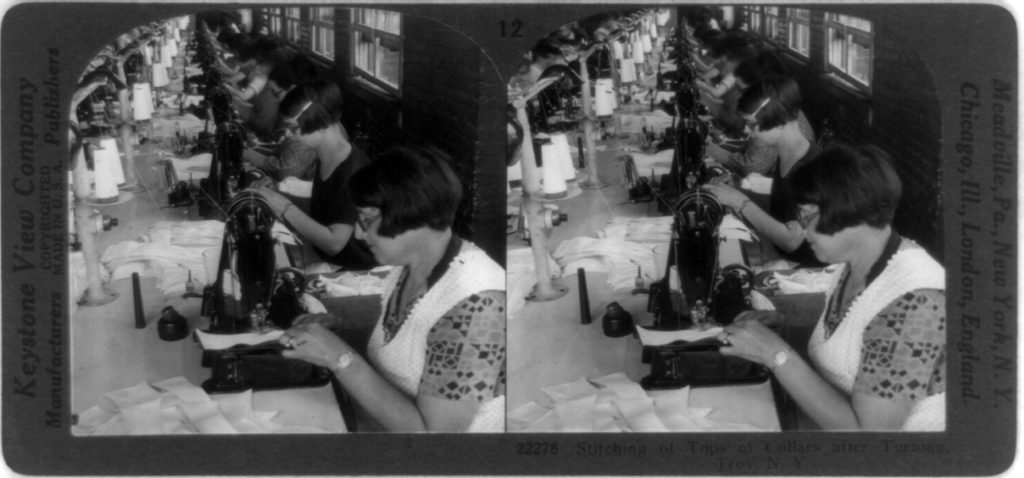We now believe that Mrs. Hannah Montague of 139 Third Street, Troy, invented the concept of the detachable collar in 1827, snipping the collar from one of her husband’s shirts in order to wash it separately from the shirtwaist, stitching it back in place when she was done. At the time “The Americana” reference library was compiled in 1912, Hannah’s name was thought lost to time: “It is unfortunate, from the point of view of the historian, that the name of this clever woman should have been lost, and it is to be hoped that her inventive genius was financially rewarded.” We don’t know whether she made any money from her invention, but we do know who got the credit: a man.
As “The Americana” reported, in 1829, “Rev. Ebenezer Brown, who had retired from the Methodist ministry to establish a dry goods store in Troy, opened a small factory that he might manufacture such collars in greater quantities.” It may well be that Brown came up with the idea of re-attaching collars with collar buttons, but no one seems to have recorded this important innovation’s first appearance. With his wife, Brown began turning out collars from his shop at 285 River Street, and soon engaged a number of additional women in the work.
Hannah did benefit in some way at least. By 1834 her husband, Orlando Montague (who was previously said to be either a blacksmith or a shoemaker) went into the collar business with Austin Granger, at 222 River Street. Other collar factories started popping up, and suddenly Troy had a booming business and a large, well-trained female workforce. Around 1845, someone thought to have the cuffs match the collar, and detachable cuffs were added to Troy’s manufactures. Sewing machines began to be used in the 1850s, despite initial resistance; the firm of Wheeler and Wilson focused its efforts on the industry and eventually provided perhaps thousands of machines, driven by steam. Far from putting women out of work, historian A.J. Weise reported that “The women who, before the use of sewing machines in the factories, had been earning fifty cents a day in stitching collars and cuffs by hand, were enabled to earn with sewing machines, from two dollars to two dollars and fifty cents a day.” Once a machine could make a button-hole (1875), the entire operation could be done by machine. In addition to collars and cuffs, Troy manufacturers made shirtwaists as well, beginning in 1845.
There were many, many collar and shirt manufacturers in Troy. You couldn’t have thrown a rock on River Street without hitting one. Arthur Weise, writing in 1889, said that seven thousand girls and women obtained work from 22 manufactories in Troy, including Earl & Wilson; Cluett, Coon & Co.,; George P. Ide & Co.; Miller, Hall & Hartwell; Corliss Brothers & Co.; United Shirt and Collar Company; H.C. Curtis & Co.; Holmes & Ide; Tim & Co.; Tim, Wallerstein & Co.; Joseph Bowman & Sons; William Barker; Wilbur, Miller & Wilbur; Fellows & Co.; Gunnison & Marvin; Ball Brothers; Wood & Lewis; C.H. McClellan; J. Stettheimer, Jr. & Co.; J.H. Osterhout; Emigh & Lobdell; and Van Zandt, Jacobs & Co.
Tomorrow we’ll look at the most famous of them all, Cluett & Peabody.


1 thoughts on “How the Collar City got its name”